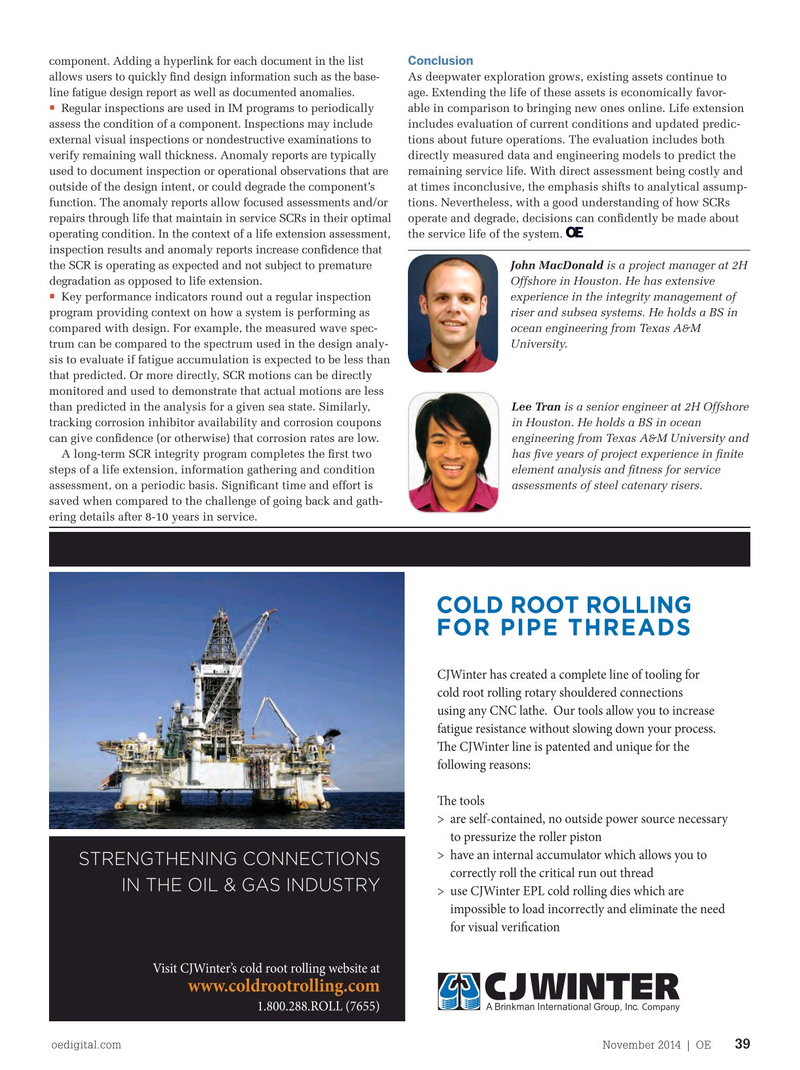
Page 37: of Offshore Engineer Magazine (Nov/Dec 2014)
Read this page in Pdf, Flash or Html5 edition of Nov/Dec 2014 Offshore Engineer Magazine
component. Adding a hyperlink for each document in the list Conclusion
As deepwater exploration grows, existing assets continue to allows users to quickly fnd design information such as the base- age. Extending the life of these assets is economically favor- line fatigue design report as well as documented anomalies.
• Regular inspections are used in IM programs to periodically able in comparison to bringing new ones online. Life extension assess the condition of a component. Inspections may include includes evaluation of current conditions and updated predic- external visual inspections or nondestructive examinations to tions about future operations. The evaluation includes both verify remaining wall thickness. Anomaly reports are typically directly measured data and engineering models to predict the used to document inspection or operational observations that are remaining service life. With direct assessment being costly and outside of the design intent, or could degrade the component’s at times inconclusive, the emphasis shifts to analytical assump- function. The anomaly reports allow focused assessments and/or tions. Nevertheless, with a good understanding of how SCRs repairs through life that maintain in service SCRs in their optimal operate and degrade, decisions can confdently be made about operating condition. In the context of a life extension assessment, the service life of the system. inspection results and anomaly reports increase confdence that the SCR is operating as expected and not subject to premature John MacDonald is a project manager at 2H degradation as opposed to life extension. Offshore in Houston. He has extensive • Key performance indicators round out a regular inspection experience in the integrity management of program providing context on how a system is performing as riser and subsea systems. He holds a BS in compared with design. For example, the measured wave spec- ocean engineering from Texas A&M trum can be compared to the spectrum used in the design analy-
University. sis to evaluate if fatigue accumulation is expected to be less than that predicted. Or more directly, SCR motions can be directly monitored and used to demonstrate that actual motions are less
Lee Tran is a senior engineer at 2H Offshore than predicted in the analysis for a given sea state. Similarly, in Houston. He holds a BS in ocean tracking corrosion inhibitor availability and corrosion coupons engineering from Texas A&M University and can give confdence (or otherwise) that corrosion rates are low.
A long-term SCR integrity program completes the frst two has fve years of project experience in fnite steps of a life extension, information gathering and condition element analysis and ftness for service assessment, on a periodic basis. Signifcant time and effort is assessments of steel catenary risers. saved when compared to the challenge of going back and gath- ering details after 8-10 years in service.
WE’RE OPEN FOR BUSINESS! ™
API Spec Q2 – Quality Management for Service Supply Organizations – lets the industry know you’re API strong.
ARE
Apply now at myCerts.api.org.
YOU
Q2?
Copyright 2014 – American Petroleum Institute, all rights reserved. API, API Spec Q2, the “Tough Business” slogan and the API logo are either trademarks or registered trademarks of API in the United States and/or other countries.
®
It’s a tough business. Look to API.
OffshoreEngineer_HalfPage_Q2Ad.indd 1 10/9/14 4:16 PM oedigital.com November 2014 | OE 39 036_OE1114_Asset4.indd 39 10/20/14 10:43 PM

 36
36

 38
38